Mars rover
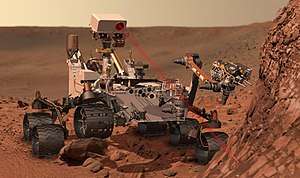
A Mars rover is an automated motor vehicle that propels itself across the surface of the planet Mars upon arrival. Rovers have several advantages over stationary landers: they examine more territory, and they can be directed to interesting features, they can place themselves in sunny positions to weather winter months, and they can advance the knowledge of how to perform very remote robotic vehicle control.
There have been four successful robotically operated Mars rovers. The Jet Propulsion Laboratory managed the Mars Pathfinder mission and its now inactive Sojourner rover. It currently manages the Mars Exploration Rover mission's active Opportunity rover and inactive Spirit, and, as part of the Mars Science Laboratory mission, the Curiosity rover. On January 24, 2016 NASA reported that current studies on Mars by the Curiosity and Opportunity rovers would be searching for evidence of ancient life, including a biosphere based on autotrophic, chemotrophic, and/or chemolithoautotrophic microorganisms, as well as ancient water, including fluvio-lacustrine environments (plains related to ancient rivers or lakes) that may have been habitable.[1][2][3][4] The search for evidence of habitability, taphonomy (related to fossils), and organic carbon on Mars is now a primary NASA objective.[1] Since June 2018, the Opportunity rover has been out of contact after going into hibernation mode in a dust storm. NASA has stated they are unsure if they will ever be able to regain contact.
Mars 2, Mars 3 and Beagle 2 were physically tethered probes; Sojourner was dependent on the Mars Pathfinder base station for communication with Earth; MER-A & B, and Curiosity were on their own. Of these MER-B and Curiosity are still active, and MER-A and Sojourner completed their missions before losing contact in 2010 and 1997 respectively.
Missions
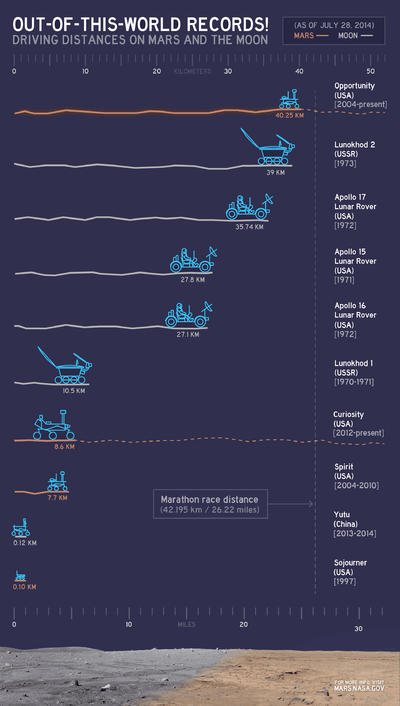
Seven rovers have been dispatched to Mars:







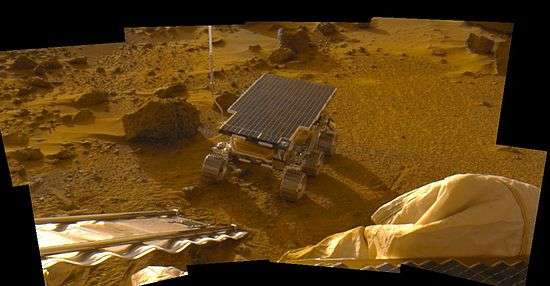
Planned
- ExoMars rover, a European effort
- Mars 2020, a NASA project
- 2020 Chinese Mars Mission
Examples of instruments

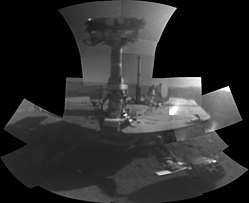
(February 14−20, 2018 / sols 4998−5004) It was taken with its microscopic imager instrument
Examples Landed instrumentation (Rovers)
- Alpha particle X-ray spectrometer (MPF + MER + MSL)
- CheMin (MSL)
- Chemistry and Camera complex (MSL)
- Dynamic Albedo of Neutrons (MSL)
- Hazcam (MER + MSL)
- MarsDial (MER + MSL)
- Materials Adherence Experiment (MPF)
- MIMOS II (MER)
- Mini-TES (MER)
- Mars Hand Lens Imager (MSL)
- Navcam (MER + MSL)
- Pancam (MER)
- Rock Abrasion Tool (MER)
- Radiation assessment detector (MSL)
- Rover Environmental Monitoring Station (MSL)
- Sample Analysis at Mars (MSL)
Locations of Mars rovers, in context
Concepts

Mars rovers in development include:
- ExoMars, by the ESA. Planned Mars launch 2018.[25] The rover will use stained glass to prevent UV from changing image colors, allowing for true color images of the surface of Mars.[26]
- Chinese Mars Rover, has been planned for a pre-2020 launch, as part of a sample-return mission.[27]
- MESR (Mars Exploration Science Rover), REX (Robot EXplorer), and MRPTA (Micro-Rover Platform with Tooling Arm) have a target destination of Mars, planned by the Canadian Space Agency (CSA).[28]
- Mars 2020, a NASA rover based on the current rover Curiosity and planned to launch in 2020.
- 2020 Chinese Mars Mission, would include an orbiter, lander and small rover.
One experimental design, not proposed for any actual mission, is:
- Mars Tumbleweed Rover, a wind-propelled rover.[29]
Cancelled or stale rover mission designs/proposals
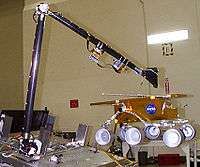
- Astrobiology Field Laboratory, proposed in the 2000-2010 period as a follow on to MSL.[32]
- Mars Astrobiology Explorer-Cacher (MAX-C), cancelled 2011[33][34]
- Mars Surveyor 2001 rover, [35]
NASA Mars rover goals (circa 2010s)
NASA distinguishes between "mission" objectives and "science" objectives. Mission objectives are related to progress in space technology and development processes. Science objectives are met by the instruments during their mission in space.
The details of rover science vary according to equipment carried. The primary goal of the Spirit and Opportunity rovers is to discover "the history of water on Mars".[36] (The presence of usable water would greatly reduce manned mission cost.)
The four science goals of NASA's long-term Mars Exploration Program are:
- Determine whether life ever arose on Mars
- Characterize the climate of Mars
- Characterize the geology of Mars
- Prepare for human exploration of Mars[37]
Gallery
- Mars Rovers
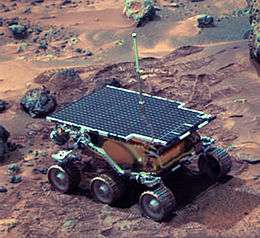 Sojourner rover on Mars.
Sojourner rover on Mars.- Sojourner rover atop Pathfinder lander.
 Comparison: Mars Sojourner rover, MER, MSL.
Comparison: Mars Sojourner rover, MER, MSL.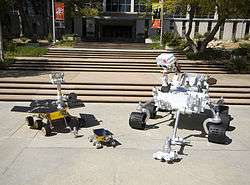 Comparison: MER, Sojourner rover, MSL.
Comparison: MER, Sojourner rover, MSL. Comparison: MER, Sojourner rover, MSL.
Comparison: MER, Sojourner rover, MSL. Concept: Manned Mars rover.
Concept: Manned Mars rover. Martian sunset viewed by the Spirit rover (May 2005).
Martian sunset viewed by the Spirit rover (May 2005).
See also
- Astrobiology
- Comparison of embedded computer systems on board the Mars rovers
- Curiosity rover
- ExoMars Lander
- InSight lander
- List of artificial objects on Mars
- Manned exploration robots
- Manned Mars rover
- Mars Exploration Rover
- Mars-Grunt
- Mars Pathfinder
- Mars Reconnaissance Orbiter
- Mars 2020 rover mission
- Odyssey orbiter
- Opportunity rover
- Radiation hardening
- Scientific information from the Mars Exploration Rover mission
- Sojourner rover
- Spirit rover
References
- 1 2 Grotzinger, John P. (January 24, 2014). "Introduction to Special Issue - Habitability, Taphonomy, and the Search for Organic Carbon on Mars". Science. 343 (6169): 386–387. Bibcode:2014Sci...343..386G. doi:10.1126/science.1249944. PMID 24458635. Retrieved January 24, 2014.
- ↑ Various (January 24, 2014). "Special Issue - Table of Contents - Exploring Martian Habitability". Science. 343 (6169): 345–452. Retrieved 24 January 2014.
- ↑ Various (January 24, 2014). "Special Collection - Curiosity - Exploring Martian Habitability". Science. Retrieved January 24, 2014.
- ↑ Grotzinger, J.P. et al. (January 24, 2014). "A Habitable Fluvio-Lacustrine Environment at Yellowknife Bay, Gale Crater, Mars". Science. 343 (6169): 1242777. Bibcode:2014Sci...343A.386G. doi:10.1126/science.1242777. PMID 24324272. Retrieved January 24, 2014.
- 1 2 "Mars 2 Lander". NASA NSSDC. Retrieved 2008-06-25.
- 1 2 NSSDC – Beagle 2. NASA
- 1 2 "Mars Exploration". 10 August 2012. Retrieved 2012-08-10.
- ↑ Boyle, Alan. "Good moves on Mars". MSNBC. Retrieved 2010-01-22.
- ↑ Times, International Business (January 26, 2010). "NASA concedes defeat in effort to free rover". Retrieved 2010-01-26.
- ↑ "NASA Concludes Attempts To Contact Mars Rover Spirit". NASA. May 24, 2011.
- ↑ "NASA's Mars Rovers Set Surface Longevity Record". NASA. May 19, 2010.
- ↑ 'Greeley Haven' is Winter Workplace for Mars Rover
- ↑ Webster, Guy; Brown, Dwayne (July 28, 2014). "NASA Long-Lived Mars Opportunity Rover Sets Off-World Driving Record". NASA. Retrieved July 29, 2014.
- ↑ Knapp, Alex (July 29, 2014). "NASA's Opportunity Rover Sets A Record For Off-World Driving". Forbes. Retrieved July 29, 2014.
- ↑ "Mars Exploration Rover Mission: All Opportunity Updates". mars.nasa.gov.
- ↑ "Mars Science Laboratory Launch". 26 November 2011. Retrieved 2011-11-26.
- ↑ Associated Press (26 November 2011). "NASA Launches Super-Size Rover to Mars: 'Go, Go!'". New York Times. Retrieved 2011-11-26.
- ↑ USGS (16 May 2012). "Three New Names Approved for Features on Mars". USGS. Retrieved 28 May 2012.
- ↑ NASA Staff (27 March 2012). "'Mount Sharp' on Mars Compared to Three Big Mountains on Earth". NASA. Retrieved 31 March 2012.
- ↑ Agle, D. C. (28 March 2012). "'Mount Sharp' On Mars Links Geology's Past and Future". NASA. Retrieved 31 March 2012.
- ↑ Staff (29 March 2012). "NASA's New Mars Rover Will Explore Towering 'Mount Sharp'". Space.com. Retrieved 30 March 2012.
- ↑ Webster, Guy; Brown, Dwayne (22 July 2011). "NASA's Next Mars Rover To Land At Gale Crater". NASA JPL. Retrieved 2011-07-22.
- ↑ Chow, Dennis (22 July 2011). "NASA's Next Mars Rover to Land at Huge Gale Crater". Space.com. Retrieved 2011-07-22.
- ↑ Amos, Jonathan (22 July 2011). "Mars rover aims for deep crater". BBC News. Retrieved 2011-07-22.
- ↑ Michael A. Taverna (October 19, 2009). "ESA Proposes Two ExoMars Missions". Aviation Week. Retrieved 2010-06-24.
- ↑ ELLIE ZOLFAGHARIFARD (15 October 2013). "How medieval stained-glass is creating the ultimate SPACE camera: Nanoparticles used in church windows will help scientists see Mars' true colours under extreme UV light".
- ↑ "China plans to land rover on Mars by 2020". SpaceDaily. 1 July 2014.
- ↑ "The Canadian Space Agency's Fleet of Rovers". Canadian Space Agency. Retrieved 2014-09-28.
- ↑ Kimberly W. Land (May 13, 2003). "A new way to explore the surface of Mars". NASA. Retrieved 2011-04-04.
- ↑ Arias, Francisco. J (2018). "CO2-Cushion Vehicle for Mars. An Alternative Locomotion for Exploration Rovers". 54nd AIAA/SAE/ASEE Joint Propulsion Conference Cincinnati, OH, Propulsion and Energy, (AIAA 2018–4492). doi:10.2514/6.2018-4492.
- ↑ Arias, Francisco. J (2018). "A Method of Attaining High Pressurized Vessels in Space, the Moon and With Particular Reference to Mars". 54nd AIAA/SAE/ASEE Joint Propulsion Conference Cincinnati, OH, Propulsion and Energy, (AIAA 2018–4688). doi:10.2514/6.2018-4488.
- ↑
- ↑ de Selding, Peter B. (20 April 2011). "ESA Halts Work on ExoMars Orbiter and Rover". Space News. Retrieved 2011-04-21.
- ↑ Svitak, Amy (18 April 2011). "U.S., Europe Plan Single-rover Mars Mission for 2018". Space News. Retrieved 2011-04-21.
- ↑
- ↑ "Mars Exploration Rover Mission: Overview". marsrovers.nasa.gov. Retrieved 2008-06-25.
- ↑ "Mars Exploration Rover Mission: Science – Looking for signs of past water on Mars". marsrovers.nasa.gov. Retrieved 2008-06-25.



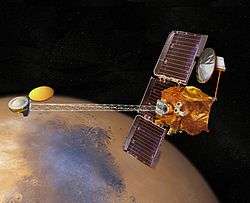
.jpg)
.jpg)